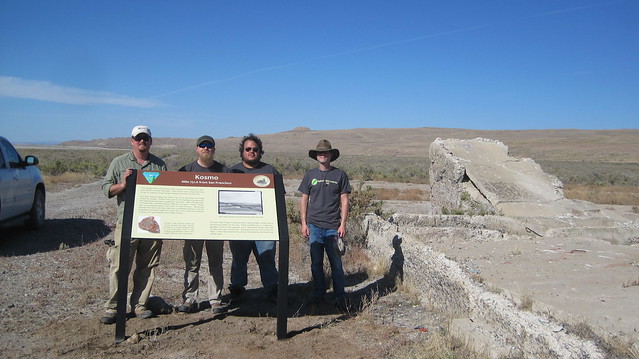Transcontinental Railroad
Learn more about the Transcontinental Railroad and see sites, the Travelstorys audio tour will guide visitors down 90 miles of original hand-constructed Transcontinental Railroad grade, managed as a National Backcountry Byway and located west of the Golden Spike National Historic Park. Visitors will pass through ghost towns and see old foundations, earthworks, culverts, and trestles which carried old steam engines, passengers, and western adventurers into new and undiscovered country. Visitors are reminded to adhere to the Archaeological Resources Protection Act of 1979 and to not move, take, or destroy any historical artifacts.
The audio tour was developed in partnership with the Utah SHPO, can be downloaded on mobile devices through the Travelstorys app or on the web, and is free to all users. Once you have downloaded the application on your mobile device, the “Transcontinental Railroad” tour can be found using the magnifying glass icon at the top of the screen. To download, press the little blue download icon on the bottom right of the tour. Due to limited cell phone service along the railroad grade, it is recommended to download the app and tour ahead of time.
Railroad History
In 1862, when the nation was engaged in civil war, President Lincoln signed the Pacific Railway Act into law, authorizing land grants and public funding for a transcontinental railroad to connect the east to the west. Two companies set to the task: the Union Pacific Railroad who started building west from Omaha, Nebraska, and the Central Pacific Railroad who started building east from Sacramento, California. Both companies required the hiring of thousands of workers, mostly of Chinese, Irish, or Mormon descent. The project took six years, millions of dollars, and 1,800 miles of track to complete. On May 10, 1869, the two railroad companies met at Promontory Point, now the Golden Spike National Historic Park.
The new railroad directly linked the people and economies of eastern and western America for the first time. As the longest continuous railroad ever completed in the world, it shorted the long and perilous voyage between the Atlantic and Pacific Oceans from several months to a matter of days. The railroad dramatically expedited the settlement of the western Great Plains, Rocky Mountains, and Great Basin. New towns, army posts, mining districts, wagon roads, and stage coach lines spread out into previously uninhabited territories.
BLM Management
The Transcontinental Railroad Grade National Backcountry Byway is the longest contiguous stretch of original railroad grade remaining in the United States. At nearly 90 miles, the byway follows the Promontory Branch built by the Central Pacific Railroad Company across Utah’s West Desert. The branch is managed by the Bureau of Land Management Salt Lake Field Office and offers visitors the vicarious experience of a vast and desolate landscape largely unchanged since the railroad’s original construction. Several stops along the route provide a glimpse into Chinese and Mormon workers’ personal lives; pottery shards, building imprints, metalwork, and other artifacts are easy to find and garner interagency support for their preservation. Interpretive signs better explain the surrounding landscape, bringing ghost towns to life. Due to its unique history and scenic beauty, the Transcontinental Railroad Grade is an Area of Critical Environmental Concern and is listed on the National Register of Historic Places.
Visitor Information
There are no facilities or services available along the backcountry byway. Gas and services are available in Snowville, Tremonton, Corinne, Brigham City, and Wendover. Limited services are available in Park Valley to the north and Montello to the west. Visitors should carry plenty of water, spare tires, and be prepared for rough roads in a remote setting. Flat tires are common along the byway; visitors should be knowledgeable on how to change a tire. Off-highway vehicle-use is limited to the byway corridor and other existing roads. Driving even one vehicle over the side of the grade and on untouched terrain can leave a scar that will last a lifetime.
The Transcontinental Railroad Grade Backcountry Byway offers over 20 interpretive sites along the grade. Visitors are encouraged to get out of their vehicles and explore the townsites. When doing so, visitors should remember to “Respect and Protect” cultural artifacts. Digging and disturbing cultural sites is illegal. Artifacts should be left in place for the enjoyment of future generations. Take only photos and leave only footprints.
Flickr Album:


